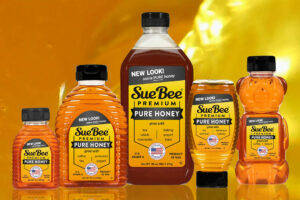AN EATING contest, dinner, and a drag show: all of these to show that Sue Bee has changed its label.
It’s a tiny change: what they’ve mostly done is center the logo and make the label’s coloring more consistent with its product (the sticker and the honey now share a similar golden tone).
“We want also to attract the younger generations. You would see all the fast-moving consumer goods, they try to update the label, and the packaging to attract the millennials, the Gen Z, for them to be part of the clients,” said Sue Bee’s Philippine distributor Global Strategic Partners Distribution, Inc.’s (GSPDI) president Peter Tiope at an interview on July 5 at the launch at the Grand Hyatt’s ballroom.
While Mr. Tiope’s company has been distributing Sue Bee Honey in the Philippines for about a quarter of a century, the honey company itself has been around for over a century. Sue Bee is a brand of the Sioux Honey Association Cooperative, founded in 1921. To this day, it’s still run as a cooperative, despite their products reaching all the corners of the globe. “The beekeepers themselves are already the owners. They could work together,” said Mr. Tiope about the co-op arrangement.
GSPDI also distributes Arm & Hammer products and Jolly Time popcorn in the Philippines (among other brands). “We’re actually one of the pioneers in terms of import and distribution of US products,” said Mr. Tiope, though he does point out that they also distribute products from Southeast Asia and Europe. “We’re very focused on US brands, because, you know, the connotation is better quality.”
He hinted about launching new brands at the World Food Expo later this month. “We’re talking to a lot of overseas suppliers. This time, it’s not only the US, but also from other parts of the world.”
DECLINING BEE POPULATIONAccording to data from the US Department of Agriculture (USDA), commercial honeybee populations had been declining since 2008, but have since stabilized. “Between January 2015 and June 2022, the US lost 11.4 million honeybee colonies and added 11.1 million,” said the agency, according to USAfacts.org, a not-for-profit, nonpartisan civic initiative for US government data.
“We experienced a lot of challenges because of global warming and climate change,” said Mr. Tiope. “The bees are actually dying. They’re trying to do something to protect the beekeepers. That also, unfortunately, drives up the price of honey worldwide.”
Meanwhile, as recently as 2022, the Philippines’ Food and Drug Administration (FDA) has issued public health warnings about compromised local honey brands. An article from the Department of Science and Technology* said that researchers from the agency’s Philippine Nuclear Research Institute have found that almost 80% of honey products sold in “groceries, souvenir shops, and online platforms” were not pure honey, but were mixed with sugar syrup (or else were almost completely made of syrup).
Mr. Tiope assured us about Sue Bee’s quality. “They have a certification, not only within the factory, but they also get certified by the USDA. The agencies are very strict. They have to make sure that everything that’s being labeled and sold has to be 100% pure.” — JL Garcia
